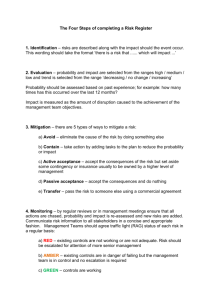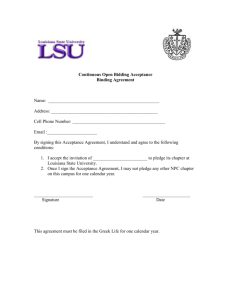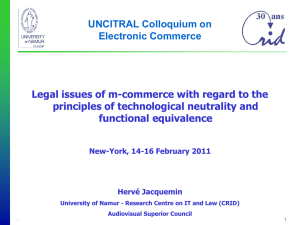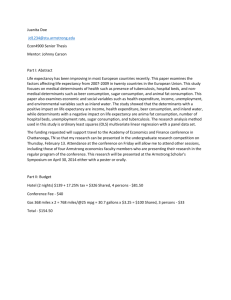Determinants for travelers acceptance and use of m
advertisement
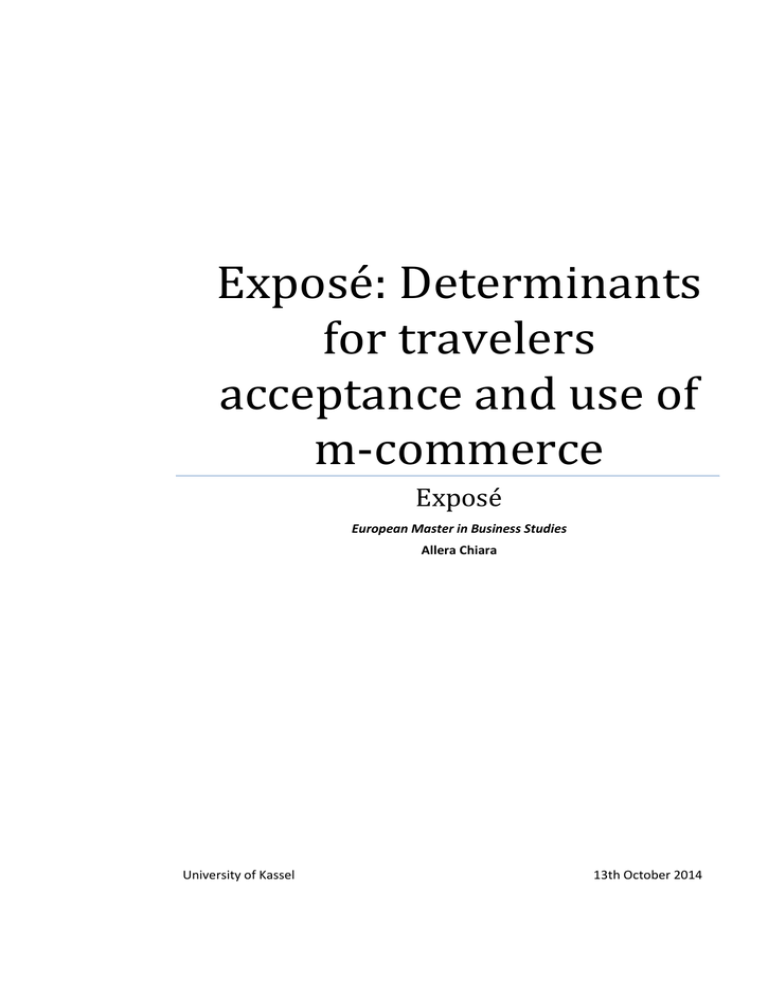
Exposé: Determinants for travelers acceptance and use of m-commerce Exposé European Master in Business Studies Allera Chiara University of Kassel 13th October 2014 Exposé: Determinants for travelers acceptance and use of m-commerce 1 Abstract Title: Determinants for travelers acceptance and use of m-commerce Keywords: Users acceptance, Tourism, M-commerce, M-tourism, Attitudes, UTAUT2 Background: Mobile commerce is a growing trend in Europe. The fast development of mobile devices and the improvement of web infrastructure allow consumers to be connected at anytime and anywhere. In the latest years, the travel industry has been adapting and taking advantage of such technological change. Customers are provided with innovative and personalized mobile services. Indeed, through a mobile device it is possible to execute a series of operations such as searching for information as soon as needed, reading opinions and advices about places, booking tickets or hosting facilities, effectuating transactions in real time. The potential for profit from mcommerce in the business is great. Despite that, German travelers reserve through mobile devices less than travelers from other EU countries. Purpose: The aim of this study is to investigate on the factors determining German travelers’ acceptance and use of mobile commerce. To do that, the Unified Theory of Acceptance and Use of Technology 2 will be used as a research model. The results may explain the reasons why German travelers do not fully benefit from mcommerce. Also, touristic organization may focus their mobile strategies on specific determinants of technological acceptance and use to increase mobile usage. Method: The data will be collected through a quantitative questionnaire run online. The target respondents group will be constituted of German travelers. Data will be analyzed through Partial Least Square method to test the correlation between the chosen variables. Exposé: Determinants for travelers acceptance and use of m-commerce 2 Table of contents Abstract ..............................................................................................................................1 Table of contents................................................................................................................2 List of abbreviations ...........................................................................................................3 List of figures ......................................................................................................................3 1. Introduction ..............................................................................................................4 2. Review of literature ..................................................................................................5 2.1. M-commerce .............................................................................................................5 2.2. M-commerce and tourism ........................................................................................7 2.3 Research model ........................................................................................................8 3. Hypotheses .............................................................................................................12 3.1. Effort expectancy, Performance expectancy, perceived risk and attitude towards m-commerce.......................................................................................................................12 3.2. Prior technological experience, perceived risk and attitude ..................................13 3.3. Prior trip experience and attitude ..........................................................................14 3.4. Attitude, facilitating conditions, social influence, price value and behavioral intention to use m-commerce ............................................................................................14 3.5. Behavioral intention to use and use behavior of m-commerce .............................15 4. Map of correlations ................................................................................................16 5. Methodology ..........................................................................................................17 6. Work plan ...............................................................................................................17 7. Overview of chapters ..............................................................................................18 Bibliography.....................................................................................................................19 Exposé: Determinants for travelers acceptance and use of m-commerce 3 List of abbreviations M-commerce Mobile Commerce TAM Technological Acceptance model UTAUT Unified Theory of Acceptance and Use of Technology UTAUT2 Unified Theory of Acceptance and Use of Technology 2 PU Perceived Usefulness PEU Perceived Ease of Use BI Behavioral Intention IS Information System List of figures Figure 1. Map of correlations among variables. .....................................................................16 Exposé: Determinants for travelers acceptance and use of m-commerce 4 1. Introduction Mobile commerce is a growing trend. The recent expansion of the mobile infrastructure, smartphones and the low cost of data accessibility provide users with data services anywhere and at any time (OECD 2013). The tourism industry is benefiting from this trend. A report published in October 2014 by Booking.com, world leading website for booking accommodation, stated that 19% of travelers around the world reserve through mobile devices. A similar result is presented by Criteo, an American travel research company. Another interesting result is that mobile booking is increasing faster than traditional desktop booking. A possible explanation to this is that m-commerce offers advantages such as personalization, ubiquity, localization and time and place convenience (Clarke, 2001) which are relevant factors in the tourism industry. Touristic companies have the great advantage to be able to endow consumers with services on-location and on-demand while they travel. As a direct consequence, organizations can differentiate their products and services to gain competitive advantage (Draghfous & Barkhi, 2009). Another important figure is that the average booking value is higher for mobile booking than for desktop booking. Thus, m-commerce in relation to the tourism industry is an important matter in literature. Previous studies were carried out to analyze the relevance of m-commerce for the travel industry (Langelund & Soren, 2007, Alqatan, Singh & Ahmad, 2011). Also, the acceptance and effective use of m-commerce in tourism were tested in the past on the basis of the TAM model in the US market and in the Chinese (Kim, Park, Morrison, 2008, Yang, Zhong & Zhang, 2013). There is a lack of literature concerning the European market which has not been investigated. An interesting statistic reveals that German travelers are three time less likely to book online than Japanese travelers (Criteo, 2014). Also, in other European countries such as Italy, France and Spain travelers are twice more likely to reserve online than Germans. Despite this result, the importance of m-commerce nowadays for a big European power as Germany cannot be underestimated. Indeed, the tourism industry is an important economic factor in Germany, accounting for 3,2% of the national GDP (World Tourism Trade Council, 2014). Also, mobile commerce in Germany is growing but not as fast as in other European countries (OECD, 2013). M-commerce is an actual and relevant topic for tourism, as previously stated. Furthermore, 79% of Exposé: Determinants for travelers acceptance and use of m-commerce 5 German travelers own a smartphone while 39% a tablet (PhoCusWright, Market research, Industry Intelligence, 2014). Therefore, a research on the behavioral and external factors which motivate German travelers to benefit from m-commerce would be relevant. In fact, the findings would allow touristic companies operating in the German market to understand why m-commerce for travellers is not as developed as in other countries and consequently it would permit to develop a tailored mcommerce strategy and increase m-commerce usage for the sector. For the reasons stated above, the aim of this study is to investigate which variables influence German travelers’ attitude, intention to use and actual use of m-commerce. The research question to be answered is the following: “Which are the determinants influencing German travelers acceptance and use of m-commerce?” 2. Review of literature In this section we will provide an overview of the literature analyzed until this moment. The literature review is structured in topics. First we will define m-commerce and present studies treating its acceptance by consumers. In the second section, we will present previous studies based on m-commerce and tourism. Finally, we will show the research model to be applied to this study. 2.1. M-commerce Topic Title M-commerce definition Indicators for the Information Society, OECD 2013 M-commerce advantages M-commerce Emerging value propositions for Mcommerce, Journal of Business Strategies, 2001 Determinants Author (Science, Information , Policy, & Commerce, 2013) Relevant Content Mobile commerce is defined as “a business model which allows a consumer to complete a commercial transaction using a mobile device, either at a point of sale, or remotely.” (Clark, 2001) The advantages of m-commerce are summed up in: Personalization Ubiquity Localization Time and place convenience (Malik, Explain constructs which Exposé: Determinants for travelers acceptance and use of m-commerce acceptance Mobile shopping acceptance Mobile shopping services acceptance Users’ acceptance of mobile services M-commerce and cultural differences of consumer acceptance of MCommerce, South Asian Journal of Management, 2013 Exploring individual personality factors as drivers of Mshopping acceptance, Industrial Management & Data Systems, 2009 Determinants of US consumer mobile shopping services adoption: implication for designing mobile shopping services, Journal of Consumer Marketing, 2010 Modelling users’ acceptance of mobile services, Electronic commerce research, 2012 Cultural impacts on the spread of Kumra, & Srivastava, 2013) (AldásManzano, Ruiz-Mafé, & SanzBlas, 2009) 6 determine m-commerce acceptance. It applies TAM to m-commerce acceptance and it adds hedonic variables. Utilitarian TAM variables affect consumers’ intention to use Mcommerce while hedonic behavioral aspects influence consumers’ acceptance. Applied to the Indian market It applies the TAM model to study which personality factors determine the acceptance of mshopping. Personality variables influence the behavioral intention to use mshopping and they impoverish the validity of TAM constructs. Perceived usefulness is not the only factor influencing behavioral intention, but also enjoyment. (K. Yang, 2010) It investigates on the determinants affecting users’ attitude and intention to use Mobile shopping services. It adds two constructs to the UTAUT model: attitude and hedonic performance expectancy. Hedonic performance expectancy affects intention to use. The study is carried out in the US (Zarmpou, Saprikis, Markos, & Vlachopoul ou, 2012) It adds functionality, Trust, Innovativeness, Relationship drivers as antecedents to the TAM model. Services are perceived as useful if trustworthy. Personal innovativeness influences the model. (Wagner & Klaus, 2008) It studies the role of cultural differences in the use of mcommerce. Exposé: Determinants for travelers acceptance and use of m-commerce Mobile direct marketing 2.2. Topic mobile commerce: an international comparison, Handbook of Research on Mobile Business, 2008 Mobile direct marketing, Handbook of Research on Mobile Business, 2008 (Wagner & Klaus, 2008) 7 It studies how m-commerce can be employed in direct marketing. M-commerce and tourism Title The role of smartphones in mediating the touristic Smartphones experience, and tourism Journal of travel research, 2012 Mobile travel, Tourism and Mobile traveler hospitality research, 2007 A Model of Traveler Acceptance of Mobil Technology M-commerce International and tourism journal of tourism research, 2008 Author (Wang, Park, & Fesenmaier, 2011) (Langelund, 2007) Relevant Content It examines how smartphones influence the touristic experience. Many aspects of the tourism industry are affected by the advent of smartphones. It examines the consumer travel behavior in relation to mcommerce. It explains variables influencing tourist acceptance of mobile devices. (Kim, Park, It adds two external variables to & Morrison, the TAM model: trip experience, 2008) technology experience. The two external variables positive influence the constructs of the TAM model Exposé: Determinants for travelers acceptance and use of m-commerce A framework explaining Online booking how consumers plan and book travel online, International Journal of management and marketing research, 2012 Predicting Tourists Decisions to Adopt Mobile Travel Booking, M-booking International acceptance Journal of uand eService, Science and Technology, 2013 (Conyette, 2007) (Y. Yang, Zhong, & Zhang, 2013) 8 It designs a framework showing the connection between online searching, planning and booking. Prior experience with the internet positively influences Online travel booking intention. It investigates users acceptance of M-booking. It applies TAM model to mobile booking and it adds perceived enjoyment, mobility and cost to the constructs. Results confirm the TAM model. Perceived enjoyment does not significantly influence behavioral intention. Applied to the Chinese market 2.3 Research model Topic Title TAM Technological acceptance model, MIS Quarterly,1989 UTAUT User acceptance of information technology: Auth or (Venkate sh, Morris, Relevant Content It determines a model of technological acceptance. It defines two variables (PU and PEU) as determinants of attitude toward using a technology. This last is influencing behavioral intention. It integrates 8 theories in one model to study technological acceptance and behavior. Exposé: Determinants for travelers acceptance and use of m-commerce toward a unified view, MIS Quarterly, 2003 Consumer acceptance and User of Information Technology: Extending the Unified Theory UTAUT2 of Acceptance and Use of Technology, MIS Quarterly, 2012 Hedonic and utilitarian motivations for Hedonic online retail performanc shopping e expectancy behavior, Journal of retailing, 2001 Applying TAM to e-services: The moderating role of perceived risk, Perceived Proceedings of risk the 36th Hawaii International Conference on System Sciences, 2003 A model of traveler acceptance of mobile Prior technology, experience International journal of tourism research Davis, & Davis, 2003) 9 Performance expectancy, efficiency expectancy, social influence and facilitating conditions are defined as determinants of behavioral intention. Behavioral intention predicts use. (Venkate sh, 2012) It adapts UTAUT to a consumer context Hedonic motivation and price value and habit are added to the previous model. (Childers, Carr, Peck, & Carson, 2001) It studies the importance of utilitarian and hedonic motivations to predict online attitudes; Utilitarian and hedonic motivation predict attitude towards technology (Feather m& Fuller, 2003) Risk is defined as the „expectation of losses associated with purchase and acts as an inhibitor to purchase behavior”. The study proofs that risk inhibits behavioral intention to use and perceived usefulness. (Kim et al., 2008) The study designs a model of traveler acceptance of mobile technology without considering important antecedents. It defines prior technological experience and prior trip experience as antecedents of technological acceptance for travelers. Exposé: Determinants for travelers acceptance and use of m-commerce 10 Several theoretical models attempt to investigate consumers’ technological acceptance. One of the most exploited and applied to explain the acceptance of different technologies is the Technological Acceptance Model (TAM) by Davis, 1985. Two constructs were defined as determinants of acceptance of the technology: perceived usefulness (PU) and perceived ease of use (PEU). Those influence attitude towards a new technology while this last will influence behavioral intention (BI) to use it. The second relevant theory which determines the design of my research model is the Unified theory of technological acceptance (UTAUT) (Venkatesh et al., 2003). This theory is based on 8 previous theories of consumer behavior and technological acceptance. The investigation of acceptance and use was applied to an organizational level. In this model, behavioral intention is determined by performance expectancy, effort expectancy, social influence and facilitating conditions. Actual use is influenced by behavioral intention. Furthermore, age, gender, experience and voluntariness to use are involved in the theory as moderators of the relationships among variables. After having being tested and applied in several studies and being its predictability confirmed, in 2012 the UTAUT model was extended to the consumers domain. UTAUT2 completed the model with three additional constructs: hedonic motivation, price value and habit. Two more studies coming up with additional constructs are relevant to the aim of the current study. First, Childers et al. found out that the motivation to purchase online has two natures to be analyzed separately: utilitarian and hedonic. Consequently, a study focused on determining the factors which influence US consumers to adopt mobile shopping services (Yang, 2010) divided the performance expectancy construct of UTAUT in utilitarian and hedonic. It was also proved that there is a correlation between effort expectancy and hedonic performance expectancy and between effort expectancy and utilitarian performance expectancy. Perceived risked was proved to be a variable negatively affecting perceived usefulness and behavioral intention to use e-commerce (Featherman & Fuller, 2003). Since m-commerce presents similar characteristics to e-commerce and considered the Exposé: Determinants for travelers acceptance and use of m-commerce 11 relative novelty of conducting transactions via mobile devices, this construct will be included in the research model. The last study providing variables for the research model investigates about travelers’ acceptance of mobile technology in the US. Here, two antecedent variables are applied to the TAM model: previous technological experience and previous trip experience (Kim et al., 2008). As a result, those two constructs were proved to be relevant in determining technological acceptance. This last study is limited to the antecedents and the TAM constructs. One of the possible improvements of the model is given by adding UTAUT constructs to it. Also, hedonic and utilitarian performance should be studied in relationship to travelers’ acceptance of mobile commerce. Hence, the variables present in the current study will be the following: Antecedents: o Previous technological experience o Previous trip experience Perceived risk Effort expectancy Performance expectancy o Utilitarian performance expectancy o Hedonic performance expectancy Attitude towards m-commerce Facilitating conditions Social influence Price value Behavioral intention Use Behavior. Exposé: Determinants for travelers acceptance and use of m-commerce 12 3. Hypotheses 3.1. Effort expectancy, Performance expectancy, perceived risk and attitude towards m-commerce To conclude, the model is aimed to define the relationship between the variables to define the determinants of travelers’ acceptance of m-commerce. Previous studies proved the positive relationship between effort expectancy and attitude and between performance expectancy and attitude (Venkatesh et al., 2003). As stated above, effort expectancy is also influencing performance expectancy. Since in this study performance expectancy a distinction between utilitarian and hedonic performance expectancy will be made, the hypotheses will be designed and tested as follow: H1. Effort expectancy influences attitude towards using m-commerce. H1a. Effort expectancy influences utilitarian performance expectancy. H1b. Effort expectancy influences hedonic performance expectancy. H2. Performance expectancy is positively related to attitude towards using mcommerce. H2a. Utilitarian performance expectancy is positively related to attitude toward using m-commerce. H2b. Hedonic performance expectancy is positively related to attitude toward using m-commerce. Perceived risk is defined as “the combination of uncertainty plus seriousness of outcome” (Bauer, 1960). This means that when consumers feel worried or uncertain about a product / service, their attitude towards it is negatively affected. Also a study presented in the previous chapter found out that perceived risk is inhibiting perceived usefulness. Therefore, the following hypotheses will be tested: H3. Perceived risk of actuating mobile transactions is negatively affecting attitude towards m-commerce. H3a. Perceived risk is negatively affecting utilitarian performance expectancy. Exposé: Determinants for travelers acceptance and use of m-commerce 13 This set of hypotheses is relevant to understand which degree of efforts travelers are willing to put in mobile commerce. We will understand how effort expectancy is affecting their performance expectancy in both its hedonic and utilitarian forms. Also, the relationship between performance expectancy and attitude will be tested to find out on which components of the mobile service enterprises will have to focus on to generate positive attitudes. In particular, the distinction between hedonic and utilitarian performance expectancy will clarify whether travelers are attracted by mobile commerce only for its functionality or also because it might provide an entertaining experience. Another relevant issue for the research is the degree of perceived risk towards mobile commerce which is affecting attitude. It is necessary to understand if the perceived risk is high or not to eventually reinsure consumers about the security of mobile transactions. In general, these first hypotheses focus on variables affecting the relationship between German consumers and m-commerce which depends exclusively on the consumer and its expectations. 3.2. Prior technological experience, perceived risk and attitude Literature provides evidence of the positive relationship between previous technological experience and attitude towards a new technology (Coniette, 2012). Therefore, the following hypotheses will be tested: H4. Technology experience has a positive influence on attitude. H4a. Technological experience has a positive influence on low effort expectancy. H4b. Technological experience has a positive influence on utilitarian performance expectancy. H4c. Technological experience has a positive influence on hedonic performance expectancy. Previous studies pointed out that perceived risk inhibits the behavioral intention to use e-commerce (Featherman & Fuller, 2003). Consumers having a previous technological experience with e-commerce are expected to perceive mobile transactions as less risky since they have already made use of virtual payments. Hence, the following hypothesis: Exposé: Determinants for travelers acceptance and use of m-commerce 14 H4d. Technological experience is lowering the degree of perceived risk. 3.3. Prior trip experience and attitude The second antecedent construct described in the section above is prior trip experience. As previously explained, it is assumed to positively influence attitude toward m-commerce. Therefore: H5. Prior trip experience has a positive influence on attitude. H5a. Prior trip experience has a positive influence on effort expectancy. H5b. Prior trip experience has a positive influence on utilitarian performance expectancy. H5c. Prior trip experience has a positive influence on hedonic performance expectancy. Studying the role of prior technological experience might enlighten if it plays a role on forming positive attitude towards mobile commerce. If it does, experienced consumers can be targeted and attracted with personalized services. Prior trip experience needs to be investigated for similar reasons. In fact, mobile commerce might be working better with experienced travelers which know what they want from their experience rather than with first time travelers. The opposite might also occur. Therefore an analysis will be relevant. 3.4. Attitude, facilitating conditions, social influence, price value and behavioral intention to use m-commerce Attitude is defined as a person’s positive or negative feelings toward a behavior (Fishbein and Ajzen, 1975). Behavioral intention indicates the individual’s readiness to perform a behavior (Ajzen, 1991). In the previous technological acceptance model, attitude resulted to influence behavioral intention. Behavioral intention was also influenced by facilitating conditions social influence (Vankatesh et al., 2003). In the UTAUT2 model, also price value is a construct included in the model. In this study it is relevant to analyze how much a consumer is willing to pay for the mobile experience. Hence, the following hypothesis: Exposé: Determinants for travelers acceptance and use of m-commerce 15 H6. Attitude has a positive correlation with behavioral intention to use mcommerce. H7. Facilitating conditions have a positive correlation with behavioral intention to use m-commerce. H8. Social influence has a positive correlation with behavioral intention to use m-commerce. H9. Perceived price value is affecting the behavioral intention to use mcommerce. 3.5. Behavioral intention to use and use behavior of mcommerce The UTAUT2 model proved that behavioral intention predicts use behavior. Therefore, a final hypothesis will be tested: H10. Behavioral intention has a positive influence on use behavior of mcommerce. The variables described above (attitude, facilitating conditions and social influence) are assumed to influence behavioral intention which is affecting the actual use of a product / service. The study of their relationships will underline the most relevant external variables on which touristic enterprises might focus to offer optimized mobile commerce experiences to their customers and increase their actual use of the service. Exposé: Determinants for travelers acceptance and use of m-commerce 16 4. Map of correlations The following graph illustrates the correlation among the constructs of the research model (fig 1). Previous technological experience and previous trip experience act as antecedents constructs. Figure 1. Map of correlations among variables. Exposé: Determinants for travelers acceptance and use of m-commerce 17 5. Methodology The hypotheses stated in the previous section will be tested through a quantitative research. An online survey will be distributed to German travelers through personal contacts and social networks. The sample group will be composed of about 385 respondents. The questions contained in the survey will be mainly structured in Likert scales to test the variables and understand the relationships between them. A similar structure was already applied to prove the relationship between the variables contained in the UTAUT2 theory (Venkatesh et al., 2012). The data collected will be studied according to the research model. The Partial Least Squares method will be employed with the support of the software SmartPLS. The aim of the research is to test the relationship between the variables of the model and understand which factors are influencing German travelers to use M-commerce. 6. Work plan Dates Task 13.10.2014 31.10.2014 Exposé 01.11.2014 01.12.2014 Theoretical background 02.12.2014 05.12.2014 Intermediate presentation draft 06.12.2014 10.12.2015 Methodology 10.12.2014 30.01.2015 Field research and intermediate presentation 01.02.2015 31.04.2015 01.04.2015 31.05.2015 02.06.2015 Analysis and elaboration Revision, implications and conclusion Deadline Task description Discussion, adaption and termination of the exposé. Literature review and draw up of the theoretical chapter of the thesis. Elaboration and handing in of intermediate presentation draft. Questionnaire design and elaboration of the methodology chapter. Questionnaire distribution and preparation of the intermediate report. Analysis of the results and visual creation. Elaboration of final report and presentation. Final presentation. Exposé: Determinants for travelers acceptance and use of m-commerce 18 7. Overview of chapters Abstract Table of contents Table of figures Table of abbreviations I. Introduction II. Literature review a. Figures: in this section information about m-commerce usage in Europe will be given. The focus will be on the tourism industry. b. Tourism and acceptance of new technologies: here previous studies will be introduced in order to determine which variables will be implemented in the UTAUT2 model. c. Research Model: the design of the research will be presented based on the UTAUT2 model combined with the variables previously explained. III. Construction of hypotheses: As a consequence of the literature review, specific hypotheses will be stated. IV. Methodology: in this section it will be explained how data to test the hypotheses will be collected and consequently analyzed. V. Analysis of the results: Results coming from data collection will be explained and the correlation between the variables of the model will be defined. VI. Scientific and managerial implication: The relevant findings for the tourism industry and a practical possible implementation will be suggested. VII. Conclusion and limitations: An answer to the research question will be given together with limitations of the study and possible future research suggestions. Bibliography Appendix Exposé: Determinants for travelers acceptance and use of m-commerce 19 Bibliography Ajzen, I. (1991). The theory of planned behavior. Organizational behavior and human decision processes, 50(2), 179-211. doi:10.1016/0749-5978(91)90020-T. Aldás-Manzano, J., Ruiz-Mafé, C., & Sanz-Blas, S. (2009). Exploring individual personality factors as drivers of m-shopping acceptance. Industrial Management & Data Systems, 109(6), 739–757. doi:10.1108/02635570910968018. Alqatan, S., Singh, D., Kamsuriah, A. (2011). A theoretic discussion of tourism mcommerce. Journal of Convergence Information Technology, 6(12), 100–106. doi:10.4156/jcit.vol6.issue12.13. Bauer, R. A. (1960). Consumer behavior as risk taking. Risk Taking and Information Handling in Consumer Behavior. D. F. Cox. Cambridge, Mass, Harvard University Press. 389-398. Booking.com (2014). Digitalization and innovation in tourism. Retrieved from: European tourism forum 2014. http://ec.europa.eu/enterprise/newsroom/cf/itemdetail.cfm?item_id=7701. Childers, T. L., Carr, C. L., Peck, J., & Carson, S. (2001). Hedonic and utilitarian motivations for online retail shopping behavior. Journal of Retailing, 77, 511– 535. doi:10.1016/S0022-4359(01)00056-2. Criteo (2014). Travel flash report. Retrieved from: http://www.criteo.com/ Featherman, M. & Fuller, M. (2003). Applying TAM to e-services adoption: the moderating role of perceived risk. Retrieved from: 36th Annual Hawaii International Conference on System Sciences http://www.hicss.hawaii.edu/HICSS36/HICSSpapers/INEMG01.pdf. Fishbein, M. & Ajzden, I. (1975). Introduction. Belief, Attitude, Intention and Behavior: An Introduction to Theory and Research. Addison-Wesley, Reading, MA. 1-18. Kim, D.-Y., Park, J., & Morrison, A. M. (2008). A model of traveller acceptance of mobile technology. International Journal of Tourism Research, 10(5), 393–407. doi:10.1002/jtr.669 Langelund, S. (2007). Mobile travel. Tourism and Hospitality Research, 7(3-4), 284– 286. doi:10.1057/palgrave.thr.6050063. Malik, A., Kumra, R., & Srivastava, V. (2013). Determinants of consumer Acceptance of m-commerce. South Asian Journal of Management. Retrieved from: http://scholar.google.com/scholar?hl=en&btnG=Search&q=intitle:Determinants +of+Consumer+Acceptance+of+M-Commerce#0. Exposé: Determinants for travelers acceptance and use of m-commerce 20 OECD (2007). Mobile commerce. Retrieved from: http://dx.doi.org/10.1787/231111848550. OECD (2013). Electronic and mobile commerce. Retrieved from: http://www.oecd.org/officialdocuments/publicdisplaydocumentpdf/?cote=DSTI/ ICCP/IE/IIS%282012%291/FINAL&docLanguage=En. PhoCusWright (2014). Tech adoption and European leisure travelers. Retrieved from: World travel market, London. http://www.wtmlondon.com/files/phocuswrightwhitepapereuropeantravelertecht rends.pdf. Venkatesh, V., Thong J. & Xu X. (2012). Consumer acceptance and use of information technology : extending the unified theory, MIS Quarterly, 36(1), 157–178. Retrieved from: http://www.jstor.org/discover/10.2307/30036540?uid=2134&uid=2&uid=70&ui d=4&sid=21104760751481 Venkatesh, V., Morris, M. G., Davis, G. B., & Davis, F. D. (2003). User acceptance of information technology: toward a unified view. MIS Quarterly, 27 (3), 425– 478. doi:10.2307/30036540. Wagner, R., & Klaus, M. (2008). Cultural impacts on the spread of mobile commerce: an international comparison. Handbook of research on mobile business, 2nd edn. IGI, Hershey, 245-259. Wagner, R., & Klaus, M. (2008). Mobile direct marketing. Handbook of research on mobile business, 2nd edn, IGI, Hershey, 269-281. Wang, D., Park, S., & Fesenmaier, D. R. (2011). The Role of Smartphones in Mediating the Touristic Experience. Journal of Travel Research, 51(4), 371– 387. doi:10.1177/0047287511426341 World Tourism Trade Council (2014). Country report, Germany. Retrieved from: http://ec.europa.eu/enterprise/sectors/tourism/tourism-businessportal/documents/business/internationalisation/germany_country_report.pdf Yang, K. (2010). Determinants of US consumer mobile shopping services adoption: implications for designing mobile shopping services. Journal of Consumer Marketing, 27(3), 262–270. doi:10.1108/07363761011038338 Yang, Y., Zhong, Z., & Zhang, M. (2013). Predicting Tourists Decisions to Adopt Mobile Travel Booking. International Journal of U- and E- Service, Science and Technology, 6(6), 9–20. doi:10.14257/ijunesst.2013.6.6.02 Zarmpou, T., Saprikis, V., Markos, A., & Vlachopoulou, M. (2012). Modeling users’ acceptance of mobile services. Electronic Commerce Research, 12(2), 225–248. doi:10.1007/s10660-012-9092-x

